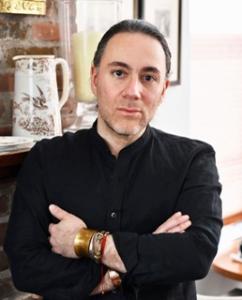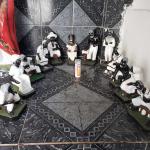Dr. Andrew Chesnut:
Antonio – you just published this new book on one of the world’s oldest superstitions at a time when institutional religious affiliation is waning and secularization is surging. I have to ask: Why the Evil Eye, and why now?
Antonio Pagliarulo:
The Evil Eye has always been with us; it’s one of the few ancient beliefs that is truly ubiquitous, present in myriad cultures and countries. In the past few years, however, there has been a kind of “boom” in the Evil Eye, resulting in a spike in jewelry sales and a huge proliferation of the most common Evil Eye symbol – the nazar. You can find the nazar on clothing, homeware products, and accessories of all sorts. There are Evil Eye backsplashes for the kitchen, notebooks and handbags and even pet leashes emblazoned with the nazar or other eye-themed symbols.
This is rooted, I believe, in what’s happening in our world and society in general. We’re in constant turmoil. The pandemic, political and socioeconomic upheaval, the rise in mass shootings, environmental disasters – the list is long and frightening. Every news headline basically tells us that we’re in big trouble and powerless to prevent bad things from happening to us. Everything is out of control but also out of our own control, and it’s the latter that really gets people thinking.
Is there anything we can control? Is there any way to feel safe? Spiritual practice gives us agency and offers us the tools not only to protect ourselves, but to learn how to accurately identify and cure the effects of negative energy, especially when it comes to the Evil Eye. Envy, resentment, anger – these are universal emotions that produce their own discord and turmoil, but when we practice any kind of protection magic, we are taking control of those energies that affect us. Becoming aware of the Evil Eye, wearing amulets, and learning how to ward it off or banish it from our lives are all within our control. Gaining knowledge about the Evil Eye is, in my opinion, the first step in spiritual self-care.
Dr. Andrew Chesnut:
What are its roots and how many cultures does it manifest in?
Antonio Pagliarulo:
Most scholars agree that the Evil Eye can be traced back 5,000 years to ancient Egypt, but many believe it can be traced as far back as Mesopotamia. In ancient Egypt, the eye was painted on boats to ensure safe travel, and on coffins to help the dead navigate the afterlife. The Eye of Horus (also called an udjat or a wedjat) was (and still is) a common symbol of protection and healing and can be found in the myth of Horus and Set.
In 1938, a series of “eye idols” – small figurines with incised eyes – were unearthed at Tell Brak (what is today northeast Syria and what was once a part of northern Mesopotamia). Thousands of these figurines were found in a building that is referred to as the “Eye Temple.” Various Sumerian incantations also reference the Evil Eye. And, of course, we can find evidence of the Evil Eye in the literature of the Greeks and Romans.
Today the Evil Eye is ubiquitous and can be found in numerous cultures, from Africa to Europe to the Middle East. How and why did such an ancient superstition survive? Though the Evil Eye is a supernatural concept, it actually has a very natural source: our emotions, namely envy and resentment. Every one of us has experienced feelings of envy, jealousy, and resentment, and every one of us has experienced the uncomfortable sting of another person’s envy. That’s why the Evil Eye is so ancient, and why it has survived – because it is rooted in a very common facet of the human condition.
Dr. Andrew Chesnut:
How did it manifest in your own family?
Antonio Pagliarulo:
I’m the child of Italian immigrants, and the Evil Eye – or il malocchio, as it’s called in Italian – was a part of everyday life in my family. I grew up in a two-story house in the Bronx and my maternal grandparents lived on the first floor. My grandmother, Caterina, was well-known in the community because she knew how to diagnose and cure malocchio using water, oil, and a secret prayer. Whenever I went downstairs, there was at least one bowl of water on her kitchen counter.
My siblings and I were warned against boasting about new toys, upcoming vacations, or personal achievements. Don’t get me wrong—we celebrated the good things in life, but we did so very privately. Growing up, we were also encouraged to “stay quiet” and not make a fuss about things. That confused me when I was a kid, but now I know that silence was (and still is) believed to keep the Evil Eye at bay.
Dr. Andrew Chesnut:
I have heard you mention your grandfather too. How did he approach “the Eye”?
Antonio Pagliarulo:
My grandfather knew a lot about hand symbols and gestures.The mano cornuta – commonly referred to as “the horns” – is probably the most common Italian gesture to ward away the Evil Eye, but my grandfather’s knowledge extended far beyond that.
He used certain hand gestures to ward away negativity but also to bring about healing. He once cured me of a sore throat using a series of hand gestures. He was also a big believer in the saints and carried saint cards in his wallet. Every Palm Sunday, he tied the palms he had collected at church into a circular amulet and hung it over the doorway that led to the kitchen.
Dr. Andrew Chesnut:
How do Evil Eye magical practices vary from tradition to tradition?
Antonio Pagliarulo:
Magical practices vary tremendously across traditions and cultures. The water and oil method that I mentioned earlier is extremely common in Italy and among Italian-Americans, but the prayers or incantations that are used to both diagnose and dispel the Evil Eye differ from region to region in Italy and also from family to family.
In Greece, for example, the most common way to smite the Evil Eye is through a prayer that’s passed down from one member of a family to another, and it’s usually male-to-female or vice versa.
In Morocco, there are numerous ways to ward away the Eye. Burning sandalwood incense is one, and other practices utilize herbs, plants, the recitation of Quranic verses, and use of henna to draw apotropaic symbols on one’s skin.
Can you look at a blue Evil Eye bead and not think of Turkey? Beads are worn, but they are also hung in homes, in offices and stores, and strung from car mirrors.
The Evil Eye is also prevalent throughout South Asia. In India, it’s referred to as nazar, and one of the most common practices to deflect it is through the application of a tilak – a mark that’s usually made on the forehead or cheek of infants, children, and adults. Kajal is a cosmetic that is used to darken a woman’s eyes.
In Arab countries, a compliment is generally followed by the words “Masha’Alla,” which means “what God wants” or “may it be what God wants.” Similarly, among observant Jews and also in Israel, the question “How have you been?” is commonly answered with “Baruch Hashem,” which means “Praise God.”
In South America, Central America, Mexico, and among Latino immigrants in the United States, belief in mal de ojo is very strong and numerous practices are employed against it. Red ribbon or string is tied around a child’s wrist or around a corner of a baby’s crib or stroller (Jews also do this and it’s called a bendel in Yiddish).
Ojo de Venado (deer’s eye) is a common amulet. In addition to limpias – cleansings – and eggs are used to remove the Evil Eye. For example, by circling an individual’s head with a raw egg, or placing an egg in a glass of water and then placing the glass under a bed.
Amulets are used in every culture, from the nazar to the hamsa to the Italian cornicello. And let’s not forget the use of saliva – spitting has been used to deflect the Evil Eye and negativity in general for generations. There are many, many practices to ward away the Eye, and to diagnose and cure it.
Dr. Andrew Chesnut:
I’m doing research in Brazil now where curiously evil eye is known as “fat eye” (olho gordo). You obviously did a lot of research for the book. Were there any surprising practices, rituals or spells you learned?
Antonio Pagliarulo:
Quite a few! One of my favorites, and by far one of the simplest, is an Armenian practice to ward away the Evil Eye: scratch or pinch your buttock immediately after receiving a compliment! It’s that simple.
I’ve known about the practice of blei gissen (“pouring lead” in Yiddish) for some time because my husband is Jewish and very much interested in Jewish magic, but I was shocked to learn that kits for this purpose (containing tin instead of lead) are actually sold in Germany today.
The most surprising – and the one closest to my heart as someone of Italian heritage with a strong food culture – was learning that in many parts of Asia and Africa, it is believed that the Evil Eye can enter through a person’s mouth while they’re eating or drinking. Because of this, the simple act of consuming a snack or meal is done with extreme caution—people eat only in their own homes or with immediate family members.
Dr. Andrew Chesnut:
You have a chapter on casting the Eye and I assume you have gotten some pushback. How do you respond?
Antonio Pagliarulo:
You definitely hit on something—this chapter has received a lot of attention and I am happy to explain its inclusion.
As a magical practitioner, I believe strongly in energy and intention and how both can be used for completely different purposes. Is it ethical to cast a curse? Are some curses justified? My answer to both questions is a resounding “Yes.”
Learning how to cast the Evil Eye is, in my opinion, a form of defensive magic. We will all, unfortunately, find ourselves in positions in which we feel threatened or unsafe, or where someone’s envy is overt. In those instances, I don’t believe it’s healthy to “turn the other cheek” or bless someone who’s wishing ill upon us.
Here, “an eye for an eye,” quite literally, makes perfect sense to me. It’s not about vengeance. It’s about restoring balance to a situation that has become unstable.
A curse like the Evil Eye can throw everything – or one particular thing – off kilter, and returning that energy to its source brings stasis. Sometimes it’s not an actual curse that’s creating discord in your life; it can be a person who’s mistreating you or a loved one, and knowing how to cast the Evil Eye through the proper use of your own energy and intention can bring protection and stability.
Dr. Andrew Chesnut:
The overarching message seems to be: “Be careful — the Eye is out there to get you!” How can you live like that?
Antonio Pagliarulo:
You are right. And living is what it’s all about.
When you become aware of what the Evil Eye is and how easily it can target any aspect of your life, you start to see the world differently, and more clearly. Your intuition becomes sharper and so does your ability to accurately know a person’s true intentions.
You become astute at hearing the envy that might be burning behind someone’s compliment. You also begin to feel the weight of an ill-intentioned glance or stare. What you should get from this knowledge is not paranoia, but peace because you know that when the Evil Eye strikes, you’ll be able to handle it.
A skilled practitioner will come to understand how to live mindfully; this means engaging fully in life and the world, but doing so with a healthy dose of caution. Celebrate your success, but don’t flaunt it. Embrace new experiences and make new friends, but don’t trust them blindly. Keep your horns raised.
It all comes down to awareness: be aware that Evil Eye is out there, and at the same time, be aware of your ability to manage it efficiently.
To quote one of my teachers, Lori Bruno: “Become a warrior, not a worrier.”
That’s very much a core message of my book.
Dr. Andrew Chesnut:
You write regularly about folk magic and pop culture. Do you think it’s a time of renaissance for the magical arts. And what’s next for you?
Antonio Pagliarulo:
It’s definitely an amazing time to be involved in the magical arts, where a resurgence is absolutely happening. I wrote about it for NBC News, as an example, a national platform where it got a lot of reaction.
Above all, I think many, many people have begun realizing that there’s great truth and wisdom in what witches, shamans, magical practitioners, and religiously observant people have been saying for a long time. I see it in two trends.
First, Nature holds the greatest power. We see it in climate change and disasters and how it impacts us personally. But we also see people leaving cities as a result of the pandemic to move to the country – reconnecting with open spaces, farms, forests, and the coast. They are embracing the cycle of seasons, a new appreciation for the land and what it offers, and how disconnection from these elements is antithetical to human existence.
Second, our minds are tremendously powerful, and our thoughts and words hold energy. Everything is interconnected. More people are starting to “wake up” to their own inherent abilities, to the power of spiritual practice, or to divinity—whether it’s ancestral worship, divination, devotion to saints and folk saints, working with the lunar cycles, and even the renewal of traditional religions.
In the intersection between these two trends are room to embrace traditions, learn about new possibilities for how we live life, and build or reimagine a moral and values code and how we behave towards one another and the world we live in. Via this route, magic (both the art and the science) has moved into the mainstream and it’s here to stay.
As per what’s next: stay tuned! But what I can say is it’ll be a new look at an old form of magic. I’ll also continue writing about, and reporting on, folk magic and pop culture and the magical community in general. Both are blessings I hope to share with others for a long time ahead. Tfoo, tfoo, tfoo .
BIO:
Antonio Pagliarulo has been published by the Washington Post, NBC News, New York Daily News, The Wild Hunt, and Religion News Service. He is the son of southern Italian immigrants and was raised in a home where the magical arts were commonplace. He lives in New York City. Visit his website and follow him on Instagram and Twitter.














